SPECTROSCOPY Section
By Chris Schur
Updated 2/26/18

|
Introduction
As an astroimager
for 4 decades now, I am always expanding my studies of the field
of astronomy, In this branch - A grating or prism is used in
conjunction with the telescope and camera to record the signature
imprints within the light itself of the chemistry of galaxies,
stars, planets and other solar system objects. While I have been
doing objective prism images of comets for decades and have had
numerous comet spectra images published, I am now starting to
get more serious on the equipment and techniques used by professional
astronomers. I will also be exploring a method using the sky
drift method for a spectroheliograph of the Sun in narrow band
wavelengths.
Spectroscopy Section
Layout. Like deep sky imaging, spectroscopy is tremendously varied
and catagorized. You can be dealing with the spectra of quasars
billions of light years away, or the surface of Mars right next
door astronomically speaking. This makes it not only interesting,
but one can never see everything in a life time of study. As
I have examined other amateur spectroscopists web sites, I found
that the best are project oriented. That is how we are going
to present this section, as an ongoing project catagorized basis.
Section
started October, 2012
|
 Instrumentation
Instrumentation
|
There are
several methods one can obtain spectra of objects in the sky,
such as the Sun, Comets or Exploding Stars. The simplest is the
use of an "Objective Prism" in which a thin glass prism
is placed in front of the camera lens and the subject which is
offset at an angle is recorded with very high efficiency as a
spectral strip. Trailing the spectrum perpendicular to the dispersion
will result in the traditional appearance of a strip with lines.
Here is an example I did of a comet:
Comet Austin
 May 6, 1990,
Objective Prism Spectra
400mm f/6.3, 15mins on
Ektar 1000, Payson
May 6, 1990,
Objective Prism Spectra
400mm f/6.3, 15mins on
Ektar 1000, Payson
| Here
in this image for example is Comet Austin with a flat wedge shaped
prism mounted in front of a 400mm lens. You can see that the
spectrum has multiple images of the comets coma in it which for
the most part represent ionised molecules such as CN and Swan
bands present. This comet was quite active and photographed with
a very green coma. Comets with plenty of dust tend to mute the
gasses spectrum and are primarily that of reflected sun light.
This appears as a bland spectrum with dark lines instead of bright
ones. You will also notice that the red part of the spectrum
is rather shortened, but the blue is drawn out. This is the non
linearity that prisms posess because they work by the principle
of refraction, and blue wavelengths are refracted more than red.
(Think rainbow). | 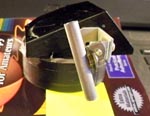 | Left:
A shot of the 15 degree surplus prism I use when shooting comets
in this manner. You can see Ive mounted it on a coffee can jar
lid which fits over the lens snugly, and Ive painted it black.
Also a small sighting tube is mounted on the top to aim the prism
at the comets. It is adjusted to compensate for the angle of
the prism. |
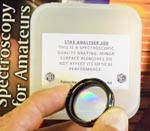 |
Another
method for obtaining spectra of celestial objects is with transmission
gratings. These are a resin film mounted on glass or on a plastic
sheet with grooves ruled into thier surfaces to disperse the
light. Those rainbow reflectors you see on products or credit
cards are an example of this, as are the rainbow pattern you
get with the reflections off of a CD or DVD disk. I use a professional
grade blazed grating in an 1.25" filter ring called the
"Star Analyzer" by Patton Hawksley, Inc. For cometary
spectra, a focal length is chosen such that the image is small
and point like. For example, a tiny 12th magnitude average comet
is small enough to allow direct imaging through the SA unit and
obtain a resonably clear spectrum. |
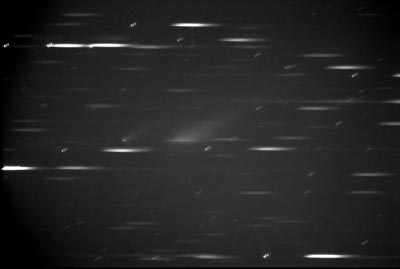 |
Here
is an example of this in effect. A very faint comet ISON when
it was dim and small in the 12.5" scope made a suitable
target for the transmission grating. In this image at the left,
you can see both the standard sharp stars image, and to thier
right side is the drawn out short spectrum. ISON is to the left
of center, and you can see its tiny nucleus and short tail. To
its right is its spectrum which can be analyzed with appropriate
software for signatures of molecules. |
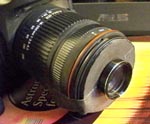 | Here we have mounted the
grating on the front of the camera lens, which when zoomed to
200mm allows a large full spectrum to be imaged. This is useful
for small point like celestial objects that are not too large
to blur the spectra out into a mush. This is suitable for small
objects like stars fields and small but bright comets. The next
panel shows an image taken with this setup on the stars of the
belt of Orion: |
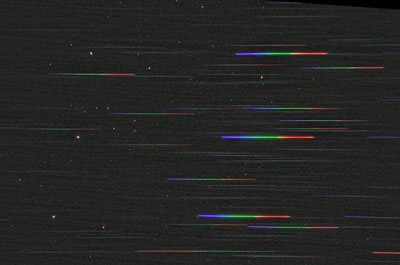 | Click
on this thumbnail for a whole page of some wide field spectroscopic
survey images with the above setup! Each star is a point source
and will be visible dimly on the left side, while the spectra
of each star is a colored streak to its right. This grating is
100 lines per millimeter ruled, such low dispersion is great
for dim objects as it does not spread the light out too much
and make it hard to see. |
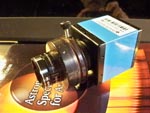 | Threaded into a camera
adapter for my Imaging Source DMK cameras, this allows me to
install the unit at the focal plane of any telescope and take
low resolution spectra of dim stars and small planetary nebula.
The idea is to be able to get the primary image and its spectra
in the same shot so measurements and calibrations can be easy
to obtain. With my 12.5" I get a dispersion of 7.9 angstroms
per pixel with this 100 line per millimeter grating. This is
how the comet ISON image above was taken, as well as many of
the spectra of assorted stars in the data below. |
 | Here is an example of the
star Sirius's spectrum as imaged with the 12.5" scope. Lines
can be seen in its spectrum which represent the chemical elements
in the stars atmosphere, in this case the hydrogen balmer lines.
Cooler stars yeild different chemistries, and for the very cool
M stars, you start to see many dim bands instead of sharp lines
from molecules making thier impressions. Hot stars do not normally
contain the spectra of molecules because they are too hot and
the energy is too high for a molecule to stay together. |
|
Projects
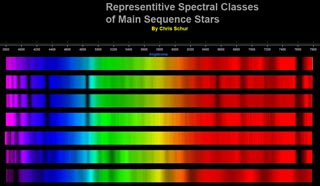 Low Resolution Spectroscopic
Series - OBAFGKM
Low Resolution Spectroscopic
Series - OBAFGKM
|
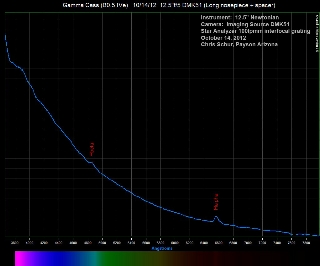 Be Stars
(B stars with emission lines)
B0 - B9
Be Stars
(B stars with emission lines)
B0 - B9
|
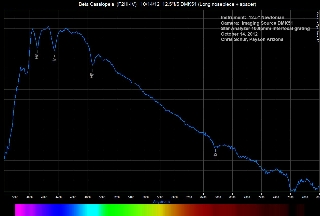 Additional
Main Sequence Normal
Dwarfs to Super Giants
OBAFGKM
Additional
Main Sequence Normal
Dwarfs to Super Giants
OBAFGKM
|
 Carbon Stars
C Class
N Class
R Class
Carbon Stars
C Class
N Class
R Class
|
|

 HOME GALAXIES EMISSION NEBS REFLECTION NEBS COMETS
GLOBULARS OPEN CLUST PLANETARIES LINKS
HOME GALAXIES EMISSION NEBS REFLECTION NEBS COMETS
GLOBULARS OPEN CLUST PLANETARIES LINKS
|